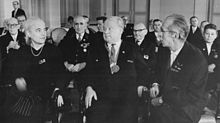Kurt Schröder (mathematician)

Kurt Erich Schröder (born July 31, 1909 in Berlin ; † July 7, 1978 there ) was a German mathematician, professor and rector at the Humboldt University in Berlin .
Life
Schröder was the son of a railroad worker and attended the Kölln High School in Berlin until 1928. While still at school he heard mathematics lectures, for example by Erhard Schmidt . He studied mathematics and physics at the University of Berlin as a scholarship holder of the German National Academic Foundation, after he originally wanted to study biology. He was a member of the socialist student union. He heard from Issai Schur , John von Neumann , Richard von Mises , Erwin Schrödinger , Ludwig Bieberbach and Herbert Feigl , among others . In 1933 he received his doctorate under Erhard Schmidt ( some sentences from the theory of continuous groups of linear transformations ). After completing his doctorate, he was an assistant at the Mathematical Institute and after Feigl's emigration to the USA took over his introductory courses in mathematics. From 1937 he was a research assistant at the German Aviation Society in Berlin-Adlershof, where he stayed until 1945. In 1937 he joined the NSDAP , completed his habilitation in 1939 (on k-parametric matrix groups) and was then a part-time lecturer at the University of Berlin. In 1974 he retired.
After the war he became a professor at the Humboldt University in 1946 and from 1947 had the chair for applied mathematics and was director of the Second Mathematical Institute. In addition to numerical mathematics and applications of mathematics in economics (operations research, statistics, cybernetics, etc.), he promoted the establishment of a computer center (from 1964, later an independent institute of the Academy of Sciences). From 1951 to 1959 he was Vice Rector for Research and then until 1965 Rector of Humboldt University. From 1959 he headed the Institute for Applied Mathematics and Mechanics of the German Academy of Sciences (DAW) and in 1971 the newly formed Central Institute for Mathematics and Mechanics (ZIMM) of the Academy of Sciences.
In 1951 he became a full member of the German Academy of Sciences. He later headed applied mathematics there, while Josef Naas headed pure mathematics. Since 1957 he was a member of the Research Council of the GDR . In 1962 he was a founding member and chairman of the Mathematical Society of the GDR . He was also chairman of the National Mathematics Committee of the GDR.
In 1956 he received the National Prize of the GDR , in 1959 the Patriotic Order of Merit in silver and in 1960 in gold; In addition, he received the badge of honor of the Society for German-Soviet Friendship in gold.
He dealt primarily with applications of analysis in physics, for example in aerodynamics - wing theory and associated with the boundary layer theory (theory of integral equations, numerical solution with difference methods) by Ludwig Prandtl . In applied mathematics he saw himself succeeding his teacher Richard von Mises, who had been expelled by the National Socialists. Another area of research was elasticity theory.
He had been married since 1937 and had a son and a daughter.
Fonts
- as editor: Mathematik für die Praxis , 3 volumes, Akademie Verlag 1964
literature
- Hannelore Bernhardt: Kurt Schröder (1909–1978). Academician and University Rector. A biographical sketch . (PDF) In: Meeting reports of the Leibniz Society of Sciences in Berlin , 113, 2012, pp. 171–188
- Annette Vogt: Schröder, Kurt . In: Who was who in the GDR? 5th edition. Volume 2. Ch. Links, Berlin 2010, ISBN 978-3-86153-561-4 .
Web links
- Literature by and about Kurt Schröder in the catalog of the German National Library
- Kurt Schröder at the Mathematics Genealogy Project
- Painting by Schröder
- Short biography at DMV
Individual evidence
- ↑ Writings of the Mathematical Seminar and Institute for Applied Mathematics of the University of Berlin , Volume 2. Teubner 1934.
- ^ About the Prandtl integro differential equations of the wing theory , Preuss meeting reports. Akad. Wiss. 1939.
| personal data | |
|---|---|
| SURNAME | Schröder, Kurt |
| ALTERNATIVE NAMES | Schröder, Kurt Erich (full name) |
| BRIEF DESCRIPTION | German mathematician |
| DATE OF BIRTH | July 31, 1909 |
| PLACE OF BIRTH | Berlin |
| DATE OF DEATH | July 7, 1978 |
| Place of death | Berlin |